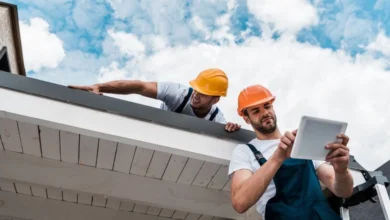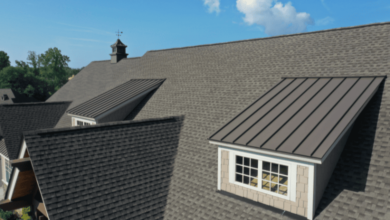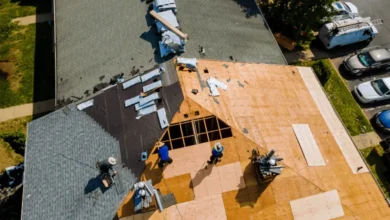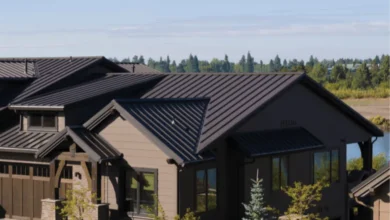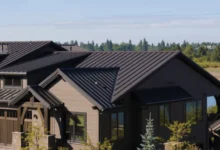Flat Roof vs. Sloped Roof – Which is Right for Your Commercial Building?
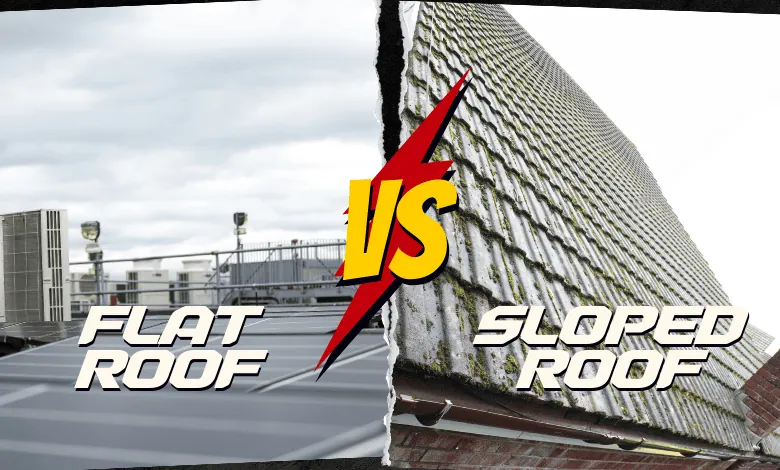
Choosing between a flat or a sloped roof is a big decision that. It affects the drainage of your building, its endurance, insulation, as well as maintenance requirements. Let us look at what’s best for your commercial structure.
The Roof Dilemma: One Shape Doesn’t Fit All
When building or renovating commercial properties, the roof is often not given the attention it deserves. The roof isn’t just an overhanging cap; it shapes how your building performs each year.
From energy efficiency and water drainage, your roof has a lot of hidden work. In a climate such as Toronto, it’s even more vital to select the right style.
So how do you decide: flat roof vs. sloped roof for your commercial space?
Let us look at the features each has and how they stand up to Canadian weather conditions, maintenance needs, and construction goals.
Understanding Flat Roof
Flat roofs are almost level, with a slight slope for drainage. They’re common on commercial buildings in Toronto.
Benefits of Flat Roofs:
- Space-Saving
- Ease of Access
- Modern Look
- Lower Initial Installation Time
Drawbacks of Flat Roofs:
- Drainage Challenges
- Shorter Lifespan
- Insulation Needs
Understanding Sloped Roof
A sloped roof has a pitch that allows snow and water to fall off easily. It’s more frequent in homes but it is still being used in commercial spaces.
Benefits of Sloped Roofs:
- Excellent Drainage
- Greater Performance
- Improved Insulation
- Weather Resistant
Drawbacks of Sloped Roofs:
- Access is more difficult
- Less Usable Space
- Installation Time
Comparison Between Flat Roof vs. Sloped Roof
You may be trying to decide between a flat and sloped roofing for your business structure. There is no universal answer. It is all about how your building operates along with your goals and your location within the city.
It is not all about style. The choice you make will affect energy consumption and maintenance requirements as well as repair costs. It can even affect how your building copes with Toronto’s volatile weather. This is how the two roofing styles differ in real-world conditions.
-
Drainage and Water Handling
Flat roofs aren’t exactly flat. They have a slight slope. But drainage is one of the major issues. Water can easily accumulate over a flat roof after heavy rain or melting snow. You need regular inspection and cleaning. If not done, it can lead to cracks, leaks, and frequent calls to emergency roof repair services. Many modern commercial structures in Toronto with flat roofs depend on scuppers or internal drains. However, they can be blocked when they are not properly maintained.
Sloped roofs are more manageable in terms of drainage. The design is angled so gravity takes care of most of the work. Rain, snow or even falling debris can slide effortlessly away. It’s a great comfort during Toronto’s lengthy cold, snowy winters. It decreases the chance of leaks, pools, and water damage. Because water doesn’t stick around, you’ll find yourself calling for emergency roof repair services far less often. It’s a smart choice in weather-prone areas.
-
Smart Space & Sustainability Benefits
Flat roofs really shine when it comes to usable rooftop space. Whether it’s solar panels, green roofing, or just a practical place for HVAC systems, flat roofs make it all possible. Many commercial buildings in Toronto use their roofs to maximize space efficiency, especially in crowded urban areas. Some even convert them into break areas or gardens. With guidance from a flat roof repair expert, your rooftop can be more than just a lid. It becomes a smart asset.
In terms of rooftop use, sloped roofs have some restrictions. Solar panel installation is possible on sloped roof, but it is crucial be careful while aligning the panels. They must be angled correctly to maximize sun exposure to ensure optimal energy efficiency. This requires precise planning. Green roofs, huge HVAC units or patios on rooftops are not a good idea here. This is why most commercial roofing projects in Toronto tend to be flat when sustainability and utility are the top priorities.
-
Installation and Construction Costs
Flat roofs are typically the preferred choice in urban environments such as Toronto because their design is easier and simpler. They are easy to install, using fewer materials and less framing as compared to sloped roofs. This saves both time and efforts. With a professional help, the installation process is a breeze, letting you focus on the other exciting parts of your project without missing a beat.
A sloped roof installation is not easy at all. It requires a more complex structure that includes angled designs and underlayers, framing, and support systems that deal with water runoff and snow effectively. This requires skilled labor along with more materials and more time for installation. This is why many commercial roofing contractors frequently schedule additional staff, hours, and plans.
-
Lifespan and Durability
Flat roofs support commercial building for many years. However, regular checks are important. Minor issues, like cracks, pooling, or membrane wear can lead to major repairs and higher expenses if left untreated. That’s why keeping in contact with a trusted flat roof repair professional is essential. They can spot problems earlier and ensure your roof is in good condition.
Sloped roofs are strong and durable. Their angled design discards rain, snow, and debris, minimizing wear over time. However, they are useful in areas with hard winters and massive snowfalls. They rarely suffer from water damage or UV-related cracking. Nevertheless, sloped roofs often require minimum repairs and tend to outlast flat systems, offering peace of mind for in the long run.
-
Maintenance and Accessibility
One of the most significant benefits of having flat roofs is its ease of access. For regular maintenance, seasonal inspections, or for urgent problems such as emergency repairs, a professional or you can safely cross the roof without using any special equipment. This makes urgent roof repairs faster, more secure, as well as cost-effective. Issues, like leaks or membrane wear are simpler to identify early and give you the opportunity to repair the issue before they turn into expensive headaches.
Maintaining a sloped roof is not easy. The steep angles make it hard to walk. However, routine tasks usually require ladders, safety harnesses or scaffolding. This slows down routine inspections as well as increases labor time and cost when repairs are needed. Whether it’s a minor leak or a larger issue, professional help becomes essential, especially in Toronto, where unpredictable weather can make emergency roof repair services even more urgent and challenging.
-
Climate & Weather Suitability
Flat roofs can handle the changing seasons in Toronto. However, they need more focus in winter. The snow doesn’t melt away as it does on slopes, it simply accumulates. If it’s left to sit for too long, the weight could cause significant pressure on the structure and may cause damage. However, it is important to keep your roof clean. Regular waterproofing and checks by a roofing expert will keep your roof strong for many years.
Sloped roofs are the most suitable for harsh Canadian winters, especially in cities heavy and frequent snowfalls. Heavy snow buildup is likely to strain your structure. The angled design helps snow melt and slide off quickly, preventing heavy buildup. This feature is a benefit. You need less manual snow removal, and less risk of leaks or sliding. This is one of the main reasons sloped roofs are an excellent choice for a long-term solution in humid, cold climates.
-
Energy Efficiency and Insulation
Flat roofs require proper planning when it comes to insulation. Because there is no attic, the insulation needs to be incorporated above or inside the roofing layers to stop heat loss. If ignored, heating bills can go high, especially during long, cold winters. But if installed correctly flat roofs can be extremely energy efficient. Most commercial flat roof Toronto companies are now focusing on modern insulation techniques to enhance the thermal efficiency and build greener, more efficient structures.
Sloped roofs provide natural energy benefits due to the space between the roof and ceiling or beneath the roof, commonly utilized as an attic or air-conditioning zone. This buffer helps to regulate indoor temperatures by limiting the direct transfer of heat. In summer, the hot air rises, and is expelled, keeping the interior cool. In winter, the insulation in the space can help keep warm. The natural airflow and separation make sloped roofs more efficient throughout the year, particularly in the cities with varied climate.
-
Regulatory and Zoning Considerations
In densely populated urban areas, flat roofs are typically more in tune with local zoning regulations. A lot of city bylaws place limitations on overall building height and roof slope to ensure the uniformity of the skyline or to ensure sightlines are protected. Flat roofs help meet those requirements more easily. Their low profile and simple structure make it easier to get building permits approved. That’s why commercial flat roofing Toronto projects often lean toward flat designs in city settings.
Parking structures are typically found in suburban and mixed-use structures because they typically contain more land available that makes it much easier and cost-effective to include large parking facilities. However, downtown cores are often subject to significant design restrictions due to the lack of space and high height limits. The need for space in urban centers prioritizes commercial and residential area over parking. In the end, developers might prefer underground parking or other alternative transportation options in urban areas.
Final Thought
In the case of flat roofs vs sloped roofs, there’s no standard answer that fits all. Consider what your building will require in the present and the future.
If roof space, easy access, and speedier repairs are your top priorities, then a flat roofing is the ideal choice. Be sure to keep communicating with a professional flat roof repair for routine maintenance.
If you’re more worried with heavy snow, long-term durability and lower maintenance, a sloped roof may work better for your property.
Whatever the case, commercial structures located in Toronto have unique challenges with zoning and weather. If you’re looking for commercial roofing contractors near me or fast and reliable emergency roofing repair services work with skilled professionals.
If you’re uncertain, PWCR is always available to assist you in making the correct choice for your commercial space.
Check out for more insightful articles that will leave you informed and inspired.

